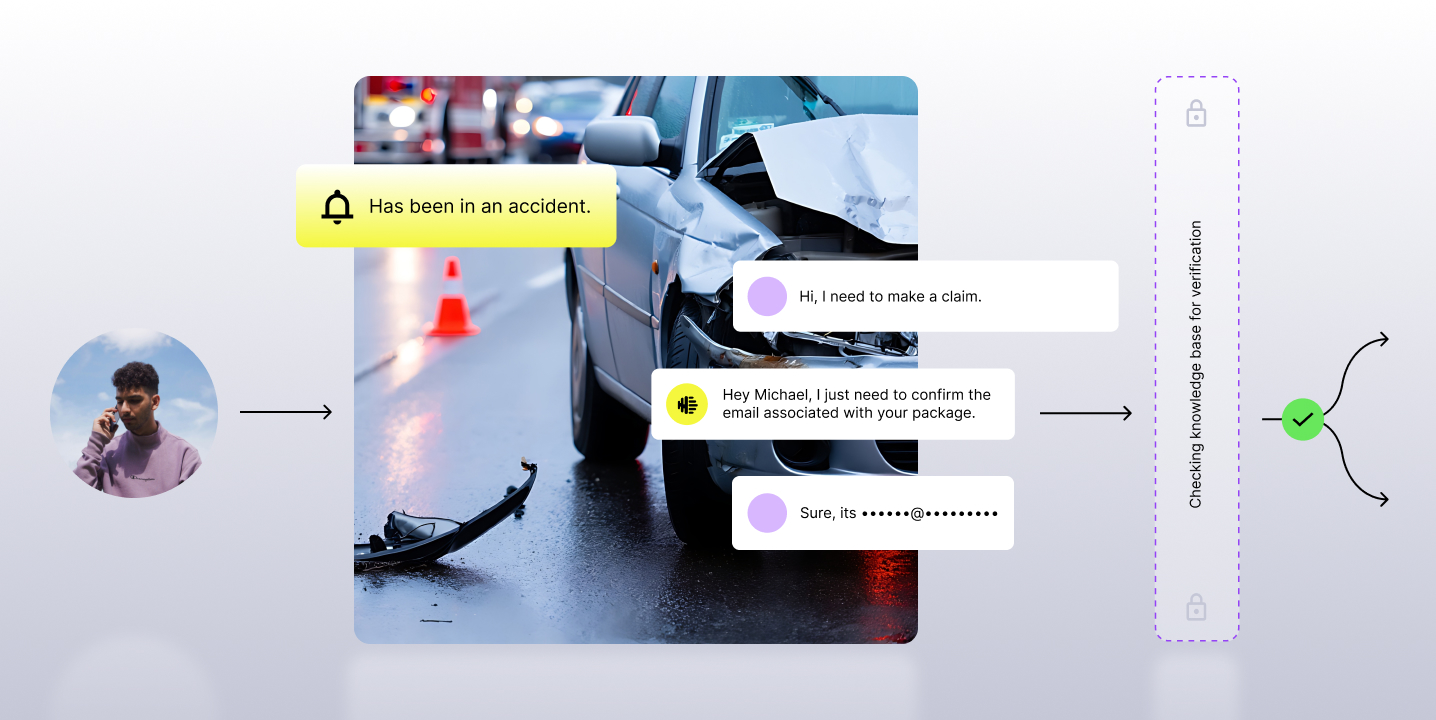What is Voice Analytics?
Today, customer expectations are constantly evolving and call centers need to stay ahead of the curve to deliver exceptional service, quality assurance, and support. One technology leading this charge is voice analytics software—a revolutionary tool that not only listens to customer interactions but also deciphers the underlying insights hidden within the spoken word.
Voice analytics in a call center is the process of using voice recognition, natural language processing (NLP), and other AI services to record voice calls, translate speech to text, and analyze the conversations.
Voice analytics software also identifies emotions and intent of the speaker by studying their audio patterns. These aspects make a voice analytics software a useful tool for contact centers. Quality analysts gain deep insights into customer needs and also use it for monitoring agent performance.
How is Voice Analytics in a Call Center Useful?
Deploying a voice analytics software is incredibly beneficial for any contact center. With proper and targeted use, companies can resolve even the trickiest issues very quickly. Contact center AI already uses automatic speech recognition and natural language processing (NLP) to transcribe and analyze 100% of agent interactions, and voice analytics is a natural continuation of this type of conversation intelligence.
In fact, according to a Gartner study, 60% of organizations will implement AI-driven voice analytics tools to enhance customer service and support. Is it time for your call center to adopt conversation analytics?
Through the lens of Observe.AI, we’ll uncover how voice analytics transcends traditional customer service boundaries to create meaningful interactions and lasting impressions in this article.
Understanding Voice Analytics
Voice analytics is a type of modern technology that involves the analysis of conversational data in spoken language form to derive valuable insights and patterns from customer interactions.
Voice analytics is a subset of speech analytics that focuses specifically on extracting information from the audio component of these interactions. Simply put, it’s the process of turning voice data into actionable intelligence.
Voice analytics transcribes spoken conversations and voice call recordings into text format using advanced speech recognition algorithms. These transcripts are then analyzed using natural language processing (NLP) and machine learning techniques to identify key words, phrases, emotions, and other relevant metrics.
By understanding the nuances of customer speech, businesses can gain deep insights into customer sentiment, preferences, and behavior, increasing customer retention, creating a better customer experience, and reducing customer churn.
So, how does voice analytics apply in modern contact centers? You can:
- Analyze customer inquiries and complaints in a way that goes far beyond the words they use
- Understand the general emotional state of the customer when they reach out for support
- Evaluate agent performance and compliance
- Uncover insights that drive improvements in customer experience, operational efficiency, and overall business performance
Key Features of Voice Analytics
Speech analytics solutions cover a range of essential features designed to extract meaningful insights from spoken conversations.
Here are some key features to know about voice analytics solutions:
Sentiment Analysis:
Voice analytics evaluates the emotional tone of customer interactions, distinguishing between positive, negative, and neutral sentiments. This helps businesses gauge customer satisfaction levels and identify areas for improvement.
Tone & Pitch Detection:
Voice analytics can detect the speaker's attitude or mood during the conversation by analyzing variations in tone and pitch. This insight enables contact centers to adjust their responses to better serve customers.
Speech Pattern Analysis:
Voice analytics identifies speech patterns such as speech rate, pauses, and interruptions, providing insights into communication dynamics. Understanding these patterns helps optimize agent performance and streamline customer interactions.
Word Choice & Phrase Analysis:
Identifies whether customers are using positive, neutral, or negative language.
Pattern Recognition for Trend Analysis:
Advanced algorithms scan thousands of calls to identify recurring issues and emerging trends. This allows contact centers to detect product issues, common service complaints, or training gaps to optimize processes proactively.
By leveraging advanced algorithms and machine learning models, Observe.AI’s voice analytics platform provides actionable insights that drive improvements in customer satisfaction, agent performance, and overall operational efficiency.
How Voice Analytics Works
Voice analytics uses AI-powered technology to analyze customer interactions in real-time. It provides valuable insights that lead to better customer experience, agent performance, and compliance monitoring.
Speech-to-Text Conversion with AI-Powered Speech Recognition
Using Automatic Speech Recognition (ASR), voice analytics transcribes spoken conversations into text instantly. This allows for real-time analytics, eliminating the need for manual call listening. Additional key features include:
- Text-to-Speech (TTS): Converts written text into lifelike speech for AI assistants, call announcements, and interactive voice response (IVR) systems, enhancing automation.
- Word Spotting: Detects specific words or phrases (e.g., “refund” or “cancel”) to flag compliance risks, categorize calls, and trigger automated actions.
- Phonetic Analysis: Recognizes accents, pronunciation differences, and phonemes for better accuracy across diverse languages and dialects.
Natural Language Processing (NLP) for Deeper Context Understanding
Simply transcribing a call isn’t enough. NLP helps identify intent, keywords, and sentiment behind words. NLP helps AI-driven systems to:
- Identify Intent: Differentiate between a question, complaint, request, or positive remark.
- Recognize Key Topics: Detect recurring themes in calls (e.g., billing issues, customer support needs, or product queries).
The Difference Between Voice Analytics & Speech Analytics
Speech analytics software primarily deals with transcribing and analyzing spoken words using AI, NLP, and keyword detection. It pulls insights from conversations by identifying keywords, topics, and compliance risks, helping businesses improve performance and training.
While speech analytics solutions interpret what was said, voice analytics goes deeper, analyzing how it was said to provide a more complete picture of customer interactions. Voice analytics uses conversation intelligence to examine tone, pitch, sentiment, and emotions in spoken interactions. It helps businesses detect frustration, engagement, or urgency based on how customers and agents speak rather than just the words used.
The Power of Voice in Customer Interaction
Unlike traditional data sources like surveys or text-based feedback, speech analytics software delves deeper into the nuances of human communication, offering invaluable insights into customer sentiment and intent.
There has been an ongoing debate in the scientific community around how much of our communication is verbal vs. nonverbal. While studies are inconclusive, we know that it’s not terribly effective to analyze one while ignoring the other. The ability of voice data software in understanding customers beyond just their words is what makes it so valuable.
Voice analytics allows businesses to decipher tone, emotion, and even pauses in speech, providing a more holistic view of customer interactions.

One notable advantage of voice analytics is its real-time capture of customer sentiment. Businesses can swiftly identify and address customer concerns by analyzing voice data as it happens, leading to improved satisfaction and loyalty.
Furthermore, voice analytics lays the groundwork for advanced technologies like Generative Artificial Intelligence (GenAI) to revolutionize contact center management.
Generative AI, powered by large language models (LLMs), thrives on well-designed voice analytics data and voice recognition models. By feeding LLMs with high-quality voice data insights, contact center management can harness AI's full potential to deliver personalized and effective customer service at scale.
Enhancing Customer Service with Voice Analytics
Voice and text analytics have emerged as game-changers in augmenting customer service and elevating overall satisfaction levels. By leveraging advanced technologies, like natural language processing (NLP) and sentiment analysis, voice analytics enables contact centers to deliver personalized and proactive customer support through better quality management and automation.
One significant way voice analytics enhances customer service is by facilitating real-time issue resolution. By analyzing customer conversations as they occur, contact center agents can swiftly identify emerging issues or concerns, allowing for immediate intervention and resolution.
For example, Observe.AI's platform can detect keywords or phrases indicating dissatisfaction, enabling agents to address issues promptly and prevent escalations.
Moreover, voice analytics empowers contact center agents with deeper customer insights. By analyzing speech patterns, emotions, and sentiments, agents gain a better understanding of each customer’s unique needs and preferences. Using this information, agents can tailor their responses and recommendations, leading to more meaningful interactions and higher customer satisfaction.
Observe.AI identifies trends and patterns, enabling contact centers to proactively address common pain points and enhance service delivery.
Benefits of Voice Analytics in Call Centers
The benefits of voice analytics include ensuring compliance with regulatory requirements and managing potential risks.
By analyzing voice data in real-time, contact centers can:
- Proactively identify compliance issues and mitigate risks before they escalate
- Monitor and analyze agent-customer interactions for regulatory compliance
- Automatically transcribe and analyze conversations to ensure adherence to legal and industry-specific regulations
The main benefits of voice analytics include:
1. Ensures Regulatory Compliance: Voice analytics monitors process adherence and compliance for individual agents by identifying the use of specific keywords in the transcripts.
2. Gauges Center Agent Performance: Voice analytics software gauges aspects like sentiment and hold times, providing insights into an agent's quality.
3. Analyses Response to New Policies: The tone of voice of a customer’s questions and their general responses aids in assessing the effectiveness of, let’s say, a new brand campaign or change in company policy.
4. Record complaints: Voice analytics highlights the reasons behind customers' unhappiness and provides solutions to fix their problems and prevent future customer churn.
5. Finds New Product Ideas: If there’s a demand for new products and services, voice analytics can scan customer perspectives using speech and tone analysis.
6. Edge Over Competition: Analyzing customer responses or complaints is useful in determining competitor strategy.
7. Cost- effective: Reliance on voice analysis negates the need for managers and quality assurance teams to perform transcription tasks manually, saving a massive amount of time and costs incurred by the company.
Voice Analytics for Compliance and Risk Management
Observe.AI’s voice analytics platform, for example, offers robust capabilities for monitoring compliance-related keywords and phrases, enabling contact centers to detect and address potential compliance breaches promptly.
Moreover, voice analytics helps contact centers manage risk by identifying and addressing potential fraud or security threats. By analyzing voice data for anomalies or suspicious patterns, contact centers can detect fraudulent activities or security breaches in real-time. Observe.AI’s advanced algorithms and machine learning capabilities enable contact centers to identify unusual behavior or deviations from typical interaction patterns, signaling potential risks or security breaches.
But the use cases don’t stop there.
Voice analytics also plays a crucial role in protecting customer data and privacy. By automatically redacting sensitive information from voice recordings and transcripts, contact centers can ensure compliance with data protection regulations and safeguard customer confidentiality.
Observe.AI’s voice analytics platform offers robust data protection features, including automated redaction of personally identifiable information (PII). These features ensure that contact centers maintain the highest data privacy and security standards.
Choosing the Right Voice Analytics Solution
With the increasing demand for AI-driven insights in contact centers, selecting the right voice analytics solution is key for improving customer experience, agent performance, and compliance management.
Key Features to Look For
With the right platform, call center voice analytics can streamline operations, enhance training programs, and improve customer satisfaction. When evaluating voice analytics software, consider the following features:
- AI-Powered Speech Recognition & Sentiment Analysis: The ability to accurately transcribe conversations, analyze tone and pitch, and detect customer emotions is essential for understanding customer sentiment and intent.
- Integration with CRM and Contact Center Platforms: A voice analytics solution should seamlessly integrate with existing systems, allowing users to easily access insights while improving workflow efficiency.
- Scalability & Real-Time Insights: The best solutions can process high call volumes instantly, offer managers automated dashboards to track key KPI metrics, and provide agents with actionable insights for better, data-driven decision-making.
Implementing Voice Analytics in Your Contact Center
Here’s a step-by-step guide to help contact centers effectively implement voice analytics:
Assess Your Needs
Assess your contact center’s specific needs and objectives for implementing voice analytics. Identify key areas where voice analytics can have the most impact, such as improving customer service, enhancing agent performance, or ensuring compliance.
Choose the Right Speech Analytics Tools
Select a reliable voice/speech analysis platform that aligns with your contact center’s requirements and goals. Look for features such as real-time speech recognition, sentiment analysis, and customizable reporting dashboards.
Integrate with Existing Systems
Ensure seamless integration of the voice analytics platform with your contact center’s existing systems and software or social media channels. Collaborate with IT teams to facilitate integration and data sharing between platforms, enabling efficient data analysis and reporting.
Train Staff
Provide comprehensive training to contact center agents and staff on using the voice analytics tools effectively. Offer training sessions on interpreting analytics insights, leveraging real-time feedback, and optimizing customer interactions based on analytics-driven insights.
Monitor Performance and ROI
Continuously monitor the performance of voice analytics initiatives and track key metrics to measure ROI. Evaluate metrics such as customer satisfaction scores, agent performance improvements, and operational efficiencies gained through voice analytics implementation.
Stay Updated
Stay abreast of advancements in voice analytics technology and industry best practices. Update your voice analytics tools and processes regularly to leverage new features and capabilities and further enhance contact center operations.
Overcoming Challenges in Voice Analytics
Like any modern tool, voice analytics comes with its own set of challenges.
Here are the most common ones to know.
Data Integration Complexity
Problem: Integrating voice analytics with existing contact center systems can be complex.
Solution: Observe.AI offers seamless integration capabilities, allowing you to integrate voice analytics with your CRM, ticketing systems, and other essential tools. We provide easy-to-use APIs and connectors, simplifying the integration process.
Data Privacy and Compliance
Problem: Ensuring data privacy and compliance with regulations like GDPR and CCPA is crucial but can be challenging to manage with your many processes.
Solution: Observe.AI prioritizes data security and compliance, employing robust encryption protocols and compliance measures. Our platform allows you to anonymize sensitive customer information and provides audit trails for regulatory compliance.
Staff Training and Adoption
Problem: Your contact center staff might not be trained enough to use voice analytics tools effectively.
Solution: Observe.AI offers comprehensive training resources and support materials to help your team understand and leverage voice analytics' full potential. Our intuitive platform interface and user-friendly features make it easy for agents to access and interpret analytics insights.
Scalability and Performance
Problem: If your contact center is growing, you’ll have scalability and performance to worry about, too.
Solution: Our cloud-based infrastructure ensures scalability, allowing you to handle increasing call volumes and data processing requirements effortlessly. Observe.AI is designed for high performance, delivering real-time analytics insights without compromising speed or reliability.
Drive Business Success with Observe.AI
It’s the age of voice analytics in customer engagement.
With Observe.AI on your side, you can unlock the full potential of voice data to drive success.
Observe.AI is committed to innovation and excellence in voice analytics. It offers advanced tools that empower businesses to extract actionable insights from customer conversations.
Observe.AI is constantly pushing the boundaries of technology to deliver superior solutions to our clients. Our team of experts is dedicated to staying ahead of the curve, continuously refining our algorithms, and expanding our capabilities to meet the evolving needs of contact centers.
Whether improving customer satisfaction, enhancing agent performance, or ensuring compliance, Observe.AI is here to help you make data-driven decisions that drive tangible results.
















